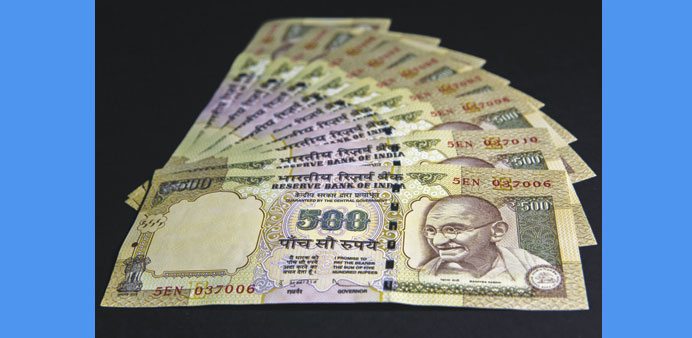The rupee fell 0.5% to 64.2050 a dollar, matching its June 8 drop, according to prices from local banks compiled by Bloomberg.
Bloomberg/Mumbai
Indian stocks dropped the most in two weeks after the nation’s biggest lender reported a larger ratio of bad debts and as prospect weakened of a national sales tax bill passing in the current parliament session.
State Bank of India tumbled the most in six months after loan slippages rose 54% from end-March, raising concerns over soured debt. Tata Steel plunged 5.5% before its results, while Vedanta, the largest copper producer, slid to a six-year low. The rupee fell the most in two months after China’s yuan devaluation drove Asian currencies lower.
The S&P BSE Sensex lost 0.8% to 27,866.09 at the close. Proceedings in the upper house of parliament, where the tax bill was listed for discussion, were halted as opposition parties blocked Prime Minister Narendra Modi’s efforts to push through legislation to boost growth. The session ends tomorrow.
“The market’s course in the near term will be charted by earnings and whether the GST bill is cleared,” RK Gupta, managing director of Taurus Asset Management Co, which has $650mn in assets, said by phone from New Delhi. Taurus is bullish on oil refiners, railroad and logistics companies.
Seventeen of the 27 Sensex members, or 68%, that have reported June-quarter earnings have matched or exceeded estimates, compared with 40% in the March quarter.
The rupee fell 0.5% to 64.2050 a dollar in Mumbai. A weaker rupee makes imports costly. India buys 80% of its crude oil from abroad.
China slashed the yuan’s daily reference rate yesterday by a record 1.9%, following data that showed exports shrank 8.3% from a year earlier in dollar terms in July.
The move jolted global markets, with the currencies of South Korea, Australia and Singapore falling at least 1% amid bets other countries will seek weaker exchange rates to keep exports competitive.
State Bank tumbled 4.9%, the most since January 30.
Net income rose 10% in the quarter ended June to Rs36.9bn ($575mn) from a year ago. While that beat the Rs34bn median of 28 analyst estimates compiled by Bloomberg, gross non-performing-asset ratio widened to 4.29% from 4.25% in March.
Tata Steel tumbled 5.5%, the worst performer on the Sensex. First-quarter profit more than doubled to Rs7.63bn from Rs3.37bn a year ago, aided by a one-time gain, the company said after trading ended. Sales declined 17% to Rs299bn.
Sun Pharmaceutical Industries, the nation’s biggest drugmaker by market value, posted a 60% drop in profit to Rs4.79bn in the June quarter. That missed the Rs11bn estimated in a Bloomberg survey of 25 analysts.
Earnings were announced after market hours. The stock added 0.1%.
Hindalco Industries, an aluminium producer, tumbled the most in two weeks, while Vedanta fell 3.3% to its lowest level since May 2009. Tata Motors, owner of Jaguar Land Rover, slid to its lowest close level since February 10, 2014. Hindustan Unilever, the biggest household products maker, decreased 2%, the most since July 21.
Global funds bought a net $11mn of Indian stocks on August 8, taking this year’s inflow to $7.37bn.
The Sensex has climbed 1.3% this year and trades at 15.6 times projected 12-month profits.
The MSCI Emerging Markets Index is valued at a multiple of 11.2.
The rupee fell the most in two months as China’s move to devalue the yuan drove Asian currencies lower.
The rupee fell 0.5% to 64.2050 a dollar in Mumbai, matching its June 8 drop, according to prices from local banks compiled by Bloomberg.
One-month implied volatility, a gauge of expected swings used to price options, rose 74 basis points to 6.34%, data compiled by Bloomberg show.
“The rupee’s weakness is a reflection of China’s yuan depreciation,” said Rohan Lasrado, head of foreign-exchange trading at RBL Bank in Mumbai.
The Bloomberg-JPMorgan Asia Dollar Index, which tracks the region’s 10 major currencies excluding Japan’s yen, retreated 1.6%.
The yuan slumped 1.8% to 6.3231 a dollar in Shanghai. The PBoC had been supporting the currency to deter capital outflows and encourage greater global usage as it pushes for official reserve status at the International Monetary Fund.
The yield on Indian sovereign bonds due May 2025 climbed one basis point to 7.80% in Mumbai, according to the Reserve Bank of India’s trading system. It ended at a one-month low on Monday amid speculation the slide in oil will help slow consumer-price gains from June’s nine-month high.


